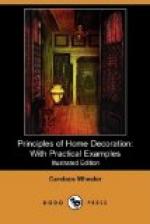CHAPTER XI
FLOORS AND FLOOR-COVERINGS
Although in ordinary sequence the colouring of floors comes after that of walls, the fact that—in important houses—costly and elaborate floors of mosaic or of inlaid wood form part of the architect’s plan, makes it necessary to consider the effect of inherent or natural colours of such floors, in connection with applied colour-schemes in rooms.
Mosaic floors, being as a rule confined to halls in private houses, need hardly be considered in this relation, and costly wood floors are almost necessarily confined to the yellows of the natural woods. These yellows range from pale buff to olive, and are not as a rule inharmonious with any other tint, although they often lack sufficient strength or intensity to hold their own with stronger tints of walls and furniture.
As it is one of the principles of colour in a house that the floor is the foundation of the room, this weakness of colour in hard-wood floors must be acknowledged as a disadvantage. The floors should certainly be able to support the room in colour as well as in construction. It must be the strongest tint in the room, and yet it must have the unobtrusiveness of strength. This makes floor treatment a more difficult problem, or one requiring more thought than is generally supposed, and explains why light rooms are more successful with hard-wood floors than medium or very dark ones.
There are many reasons, sanitary as well as economic, why hard-wood floors should not be covered in ordinary dwelling-houses; and when the pores of the wood are properly filled, and the surface kept well polished, it is not only good as a fact, but as an effect, as it reflects surrounding tints, and does much to make up for lack of sympathetic or related colour. Yet it will be found that in almost every case of successful colour-treatment in a room, something must be added in the way of floor-covering to give it the sense of completeness and satisfaction which is the result of a successful scheme of decoration.




